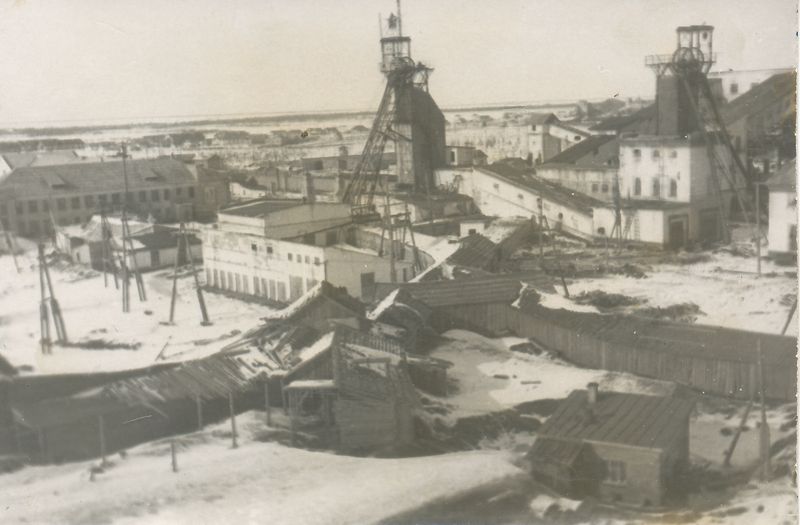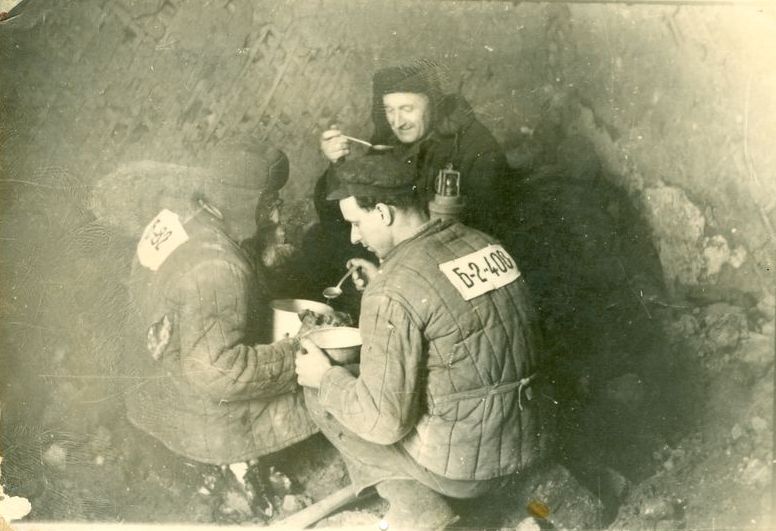|
Intalag
The Inta Corrective Labor Camp (Intalag) (russian: ąśąĮčéąĖ╠üąĮčüą║ąĖą╣ ąĖčüą┐čĆą░ą▓ąĖ╠üč鹥ą╗čīąĮąŠ-čéčĆčāą┤ąŠą▓ąŠ╠üą╣ ą╗ą░╠üą│ąĄčĆčī, ąśąĮčéą░ą╗ą░ą│, also abbreviated as Intinlag, Intlag, and Intastroy) was a forced labor camp of the Gulag, which existed between 1941 and 1948 near the town of Inta in the Komi Autonomous Soviet Socialist Republic. Prisoners at the camp were mainly engaged in the mining of local coal deposits. History Intalag was established on 17 November 1941 by being separated from Vorkutlag. Despite its name, the camp was not actually located at Inta until 1942, being initially located at Vorkuta. The first camp commander was Captain Mikhail Savich Zdunis, who led it until 17 July 1942, and it was subordinated to the General Directorate of Railway Construction Camps (GULZHDS). The camp's prisoners were tasked with mining the Inta coal deposit and building and operating (from 11 September 1942) the Inta Central Electric System. On 27 July, Senior Lieutenan ... [...More Info...] [...Related Items...] OR: [Wikipedia] [Google] [Baidu] |
Minlag
200px, Political prisoners in Gulag eating lunch (on the left Lithuanian Pranas Ivanauskas) Minlag or Mineralny Camp Directorate (ą£ąĖąĮą╗ą░ą│, ą£ąĖąĮąĄčĆą░ą╗čīąĮčŗą╣ ą╗ą░ą│ąĄčĆčī, ą×čüąŠą▒čŗą╣ ą╗ą░ą│ąĄčĆčī Ōä¢ 1 (Special Camp no. 1), ą×čüąŠą▒ą╗ą░ą│ Ōä¢ 1) was an MVD special camp for political prisoners within the Gulag system of the Soviet Union. It was established on February 28, 1948 based on the Inta labor camp (Inta ITL), Komi ASSR. In 1954, after Stalin Joseph Vissarionovich Stalin (born Ioseb Besarionis dze Jughashvili; ŌĆō 5 March 1953) was a Georgian revolutionary and Soviet political leader who led the Soviet Union from 1924 until his death in 1953. He held power as General Secret ...'s death it was reorganized into an ordinary Mineralny Corrective Labor Camp (ą£ąĖąĮąĄčĆą░ą╗čīąĮčŗą╣ ąśąóąø, Mineralny ITL). [...More Info...] [...Related Items...] OR: [Wikipedia] [Google] [Baidu] |
Gulag
The Gulag, an acronym for , , "chief administration of the camps". The original name given to the system of camps controlled by the State Political Directorate, GPU was the Main Administration of Corrective Labor Camps (, )., name=, group= was the government agency in charge of the Soviet Union, Soviet network of Correctional labour camp, forced labour camps which were set up by order of Vladimir Lenin, reaching its peak during Joseph Stalin's rule from the 1930s to the early 1950s. English-language speakers also use the word ''gulag'' in reference to each of the forced-labor camps that existed in the Soviet Union, including the camps that existed in the History of the Soviet Union (1927ŌĆō1953), post-Lenin era. The Gulag is recognized as a major instrument of political repression in the Soviet Union. The camps housed a wide range of convicts, from petty criminals to political prisoners, a large number of whom were convicted by simplified procedures, such as NKVD troikas or ... [...More Info...] [...Related Items...] OR: [Wikipedia] [Google] [Baidu] |
Inta
Inta (russian: ąśąĮčéą░╠ü, kv, ąśąĮčéą░) is a town in the Komi Republic, Russia. Population: History Inta was founded circa 1940 as a settlement to support a geological expedition to explore coal deposits and projecting of mines. The city's name is in the Nenets language and means 'well-watered place.' During the Soviet era, a "corrective labor camp", Intalag, was located here. Administrative and municipal status Within the framework of administrative divisions, it is, together with two urban-type settlements ( Verkhnyaya Inta and Kozhym) and twenty rural localities, incorporated as the town of republic significance of IntaŌĆöan administrative unit with the status equal to that of the districts.Law #16-RZ As a municipal division, the town of republic significance of Inta is incorporated as Inta Urban Okrug.Law #11-RZ Transportation It is served by the Inta Airport and the KotlasŌĆōVorkuta railway line. Inta is situated on the banks of the river Bolshoya Inta. Transmit ... [...More Info...] [...Related Items...] OR: [Wikipedia] [Google] [Baidu] |
Maxim Stepanov
Maxim Osipovich Stepanov (August 1893 ŌĆō 25 September 1945) was a Soviet komkor (corps commander). He fought for the Imperial Russian Army in World War I before going over to the Bolsheviks during the subsequent civil war. He received the Order of the Red Banner twice (1920, 1922). During the Great Purge, Stepanov's colleague division commissar Peter Maximovich Feldman (standing to his left in the group photo behind Alexander Yegorov) was executed on August 22, 1938. On November 28, 1938, the Central Committee of the Communist Party of the Soviet Union made the decision to dismiss Stepanov from the military, which was carried out the next day. He was arrested on December 9, 1938. He initially pleaded guilty to the charges he was accused of, but then withdrew his plea. He was convicted on May 31, 1939 and sentenced to 20 years imprisonment. He survived the Second World War, but did not participate in it. He died shortly after the end of the SovietŌĆōJapanese War of 1945 in a ... [...More Info...] [...Related Items...] OR: [Wikipedia] [Google] [Baidu] |
Aleksei Kapler
Aleksei (born Lazar) Yakovlevich Kapler (also Alexei, russian: link=no, ąÉą╗ąĄą║čüąĄą╣ (born ąøą░ąĘą░čĆčī) ą»ą║ąŠą▓ą╗ąĄą▓ąĖčć ąÜą░ą┐ą╗ąĄčĆ; 28 September 1903 ŌĆō 11 September 1979) was a prominent Soviet filmmaker, screenwriter, actor and writer. He was known as screenwriter of many Soviet movies, such as '' Lenin in 1918'', '' Amphibian Man'', '' The Blue Bird'' and '' Striped Trip'', as well as one of the anchors and directors of TV program '' Kinopanorama'' (a cinema overview). In 1941, Kapler was awarded the Stalin Prize. Internments in the Gulag Kapler is also known as the first love of Joseph Stalin's then teenage daughter Svetlana Alliluyeva, who was more than 20 years his junior. According to Stalin's daughter, that was the reason for Kapler to be sentenced in 1943 to five years in exile on charges of anti-Soviet agitation. He was sent to Vorkuta region, where he worked as a photographer and lived in a tiny room partitioned off in the corner of the local photo studio. In ... [...More Info...] [...Related Items...] OR: [Wikipedia] [Google] [Baidu] |
MVD Special Camp
MVD special camps of the Gulag (russian: ą×čüąŠą▒čŗąĄ ą╗ą░ą│ąĄčĆčÅ ą£ąÆąö, ąŠčüąŠą▒ą╗ą░ą│ąĖ, ''osobye lagerya'', osoblags) was a system of special labor camps established addressing the February 21, 1948 decree 416ŌĆö159čüčü of the USSR Council of Ministers of February 28 decree 00219 of the Soviet Ministry of Internal Affairs exclusively for a "special contingent" of political prisoners, convicted according to the more severe sub-articles of Article 58 (Enemies of people): treason, espionage, terrorism, etc., for various real political opponents, such as Trotskyites, "nationalists" (Ukrainian nationalism), white ├®migr├®, as well as for fabricated ones. History In 1954, after the death of Stalin, most of them were reorganized into regular corrective labor camps. [...More Info...] [...Related Items...] OR: [Wikipedia] [Google] [Baidu] |
Memorial (organization)
Memorial ( rus, ą£ąĄą╝ąŠčĆąĖą░ą╗, p=m╩▓╔¬m╔Ör╩▓╔¬╦ła╔½) is an international human rights organisation, founded in Russia during the fall of the Soviet Union to study and examine the human rights violations and other crimes committed under Joseph Stalin's reign. Prior to its dissolution in Russia, it consisted of two separate legal entities, Memorial International, whose purpose was the recording of the crimes against humanity committed in the Soviet Union, particularly during the Stalinist era, and the Memorial Human Rights Centre, which focused on the protection of human rights, especially in conflict zones in and around modern Russia. A movement rather than a centralized organization, as of December 2021 Memorial encompassed over 50 organisations in Russia and 11 in other countries, including Kazakhstan, Ukraine, Germany, Italy, Belgium and France. Although the focus of affiliated groups differs from region to region, they share similar concerns about human rights, documenti ... [...More Info...] [...Related Items...] OR: [Wikipedia] [Google] [Baidu] |
General Directorate Of Railway Construction Camps
A general officer is an officer of high rank in the armies, and in some nations' air forces, space forces, and marines or naval infantry. In some usages the term "general officer" refers to a rank above colonel."general, adj. and n.". OED Online. March 2021. Oxford University Press. https://www.oed.com/view/Entry/77489?rskey=dCKrg4&result=1 (accessed May 11, 2021) The term ''general'' is used in two ways: as the generic title for all grades of general officer and as a specific rank. It originates in the 16th century, as a shortening of ''captain general'', which rank was taken from Middle French ''capitaine g├®n├®ral''. The adjective ''general'' had been affixed to officer designations since the late medieval period to indicate relative superiority or an extended jurisdiction. Today, the title of ''general'' is known in some countries as a four-star rank. However, different countries use different systems of stars or other insignia for senior ranks. It has a NATO rank sc ... [...More Info...] [...Related Items...] OR: [Wikipedia] [Google] [Baidu] |
Two Prisoners In Intalag
2 (two) is a number, numeral and digit. It is the natural number following 1 and preceding 3. It is the smallest and only even prime number. Because it forms the basis of a duality, it has religious and spiritual significance in many cultures. Evolution Arabic digit The digit used in the modern Western world to represent the number 2 traces its roots back to the Indic Brahmic script, where "2" was written as two horizontal lines. The modern Chinese and Japanese languages (and Korean Hanja) still use this method. The Gupta script rotated the two lines 45 degrees, making them diagonal. The top line was sometimes also shortened and had its bottom end curve towards the center of the bottom line. In the Nagari script, the top line was written more like a curve connecting to the bottom line. In the Arabic Ghubar writing, the bottom line was completely vertical, and the digit looked like a dotless closing question mark. Restoring the bottom line to its original horizontal ... [...More Info...] [...Related Items...] OR: [Wikipedia] [Google] [Baidu] |
Vorkuta
Vorkuta (russian: ąÆąŠčĆą║čāčéą░╠ü; kv, ąÆė¦čĆą║čāčéą░, ''V├Črkuta''; Nenets for "the abundance of bears", "bear corner") is a coal-mining town in the Komi Republic, Russia, situated just north of the Arctic Circle in the Pechora coal basin at the river Vorkuta. In 2010 its population was 70,548, down from 84,917 in 2002. Vorkuta is the fourth largest city north of the Arctic Circle and the easternmost town in Europe. It is also the coldest city in all of Europe, boasting a record cold temperature of ŌłÆ52 ┬░C (ŌłÆ61 ┬░F). Vorkuta's population has dropped steadily since the fall of the Soviet Union, when mines were privatized and many people began moving farther south. Many of the mines have been abandoned and by September 2020, the city's estimated population was only about 50,000. A report in March 2021 described the villages in the area as "ghost towns" with many "abandoned structures". History In 1930 the geologist Georgy Chernov (1906ŌĆō2009) discovered s ... [...More Info...] [...Related Items...] OR: [Wikipedia] [Google] [Baidu] |


